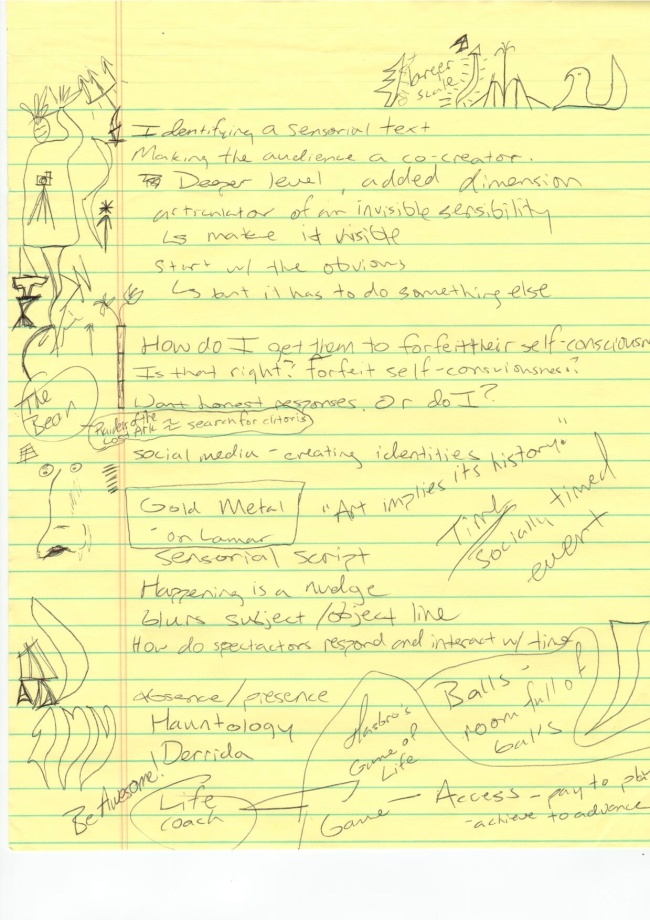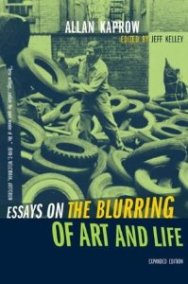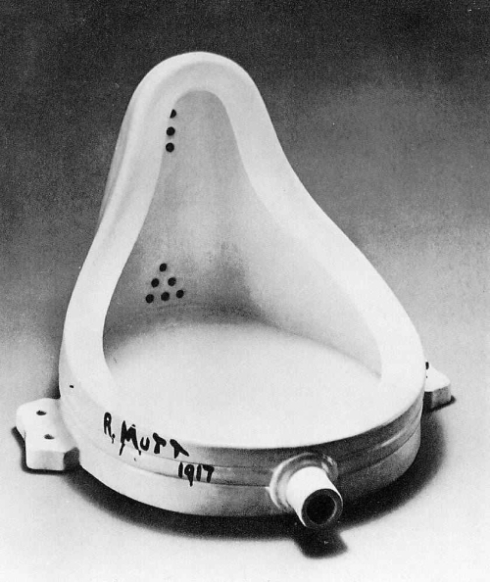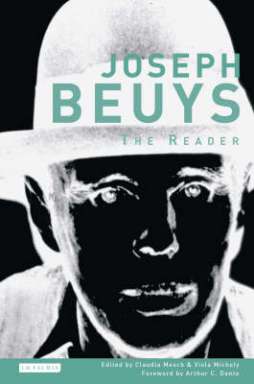Our second assignment in Performance Installation class was called “High Points of Your Life”
The basic premise was, choose seven high points from our life (good, bad, or otherwise). These high points had to, essentially, manifest in an object (found or created), a sound, a video, a text, has to be performed, and consider spatial relationships. Shape all of these to a perspective and take a point of view (implied that it’s other than our own).
So, here are my notes on the assignment. Again, you’ll notice they’re somewhat brief. Sometimes the things that happen in my head go too fast to write down…
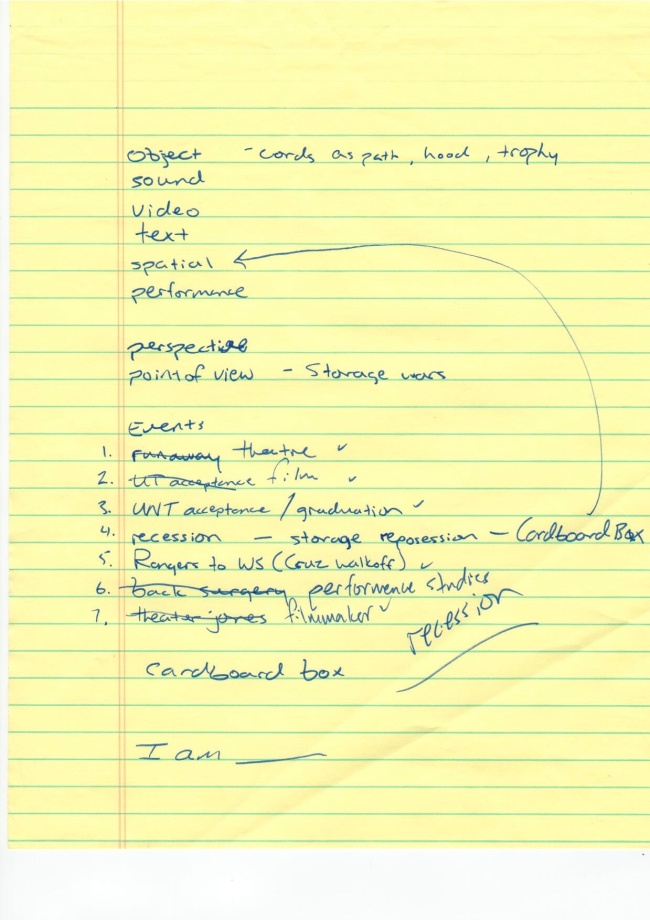
And, here is the finished product…
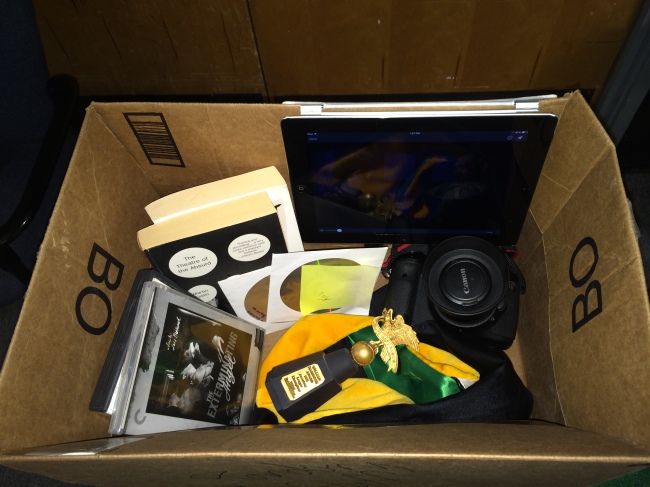


As you can see from the notes, I began with very practical life events, but soon moved to more abstract concepts.
But, at one point I realized that I had a major dividing line in my life. It was in 2009 amid the depression. I’d recently moved, and it had been before I had another place to go. So, I put all my stuff in a storage unit. However, even after I found a new house, I was so busy and I knew the move was only for a year, so I left most of the stuff in the storage unit. Int the meantime I had started a business (an art gallery I co-owned with an artist friend), and the recession had hit – closing said gallery eventually. And here’s where I ran into a problem.
The recession was hard. I wasn’t making very much money at the gallery as most of my labor was essentially sweat equity. Also, I ended up getting screwed over by departing roommates and stiffed on rent. Because of this paying bills became a sporadic event. That said, I knew my storage unit was most important, and I tried to pay the bill as often as possible.
At one point, I’d sent a check that would cover two months and any late fees I’d accumulated. However, a couple of weeks later I got a phone call from them. My storage unit was about to be auctioned off unless I paid in the next couple of hours. I asked about the check I’d sent, almost certain that I’d seen it clear the bank. They said it was $14 short of what I’d owed and weren’t sure if I wanted it applied to my balance or wanted to send another check for the right amount. Mind you, they waited until right before they were going to auction it to tell me about this issue, which is real flimsy in the first place. Of course apply it to the balance. Then, call me and tell me to send you $14 more dollars. But, this was a setup. I got the money together and called them back, but no one answered. I called a dozen times over the next few hours. Never an answer.
About a month later I got a check in the mail for $175. My cut after the balance owed was paid off of what they auctioned it for.
Doing the math, that means most of what I owned, most of my life, was worth less than $600.
Furniture, clothes, hundreds of DVD’s, hundreds of books, a lot of my masters notes, papers, etc. Keepsakes, gifts, mementos. All gone. Stolen, essentially.
But, I was so low at that point there was no fight left in me.
The gallery closed soon after. I had a falling out at grad school. Got screwed over by friends. Had the absolute worst breakup of my life. And then got most of my stuff stolen by a shady storage place. I’d lost everything. I was at rock bottom.
I moved back into my parents’ house and went back to work in the family business. The very thing I thought I’d escaped from just three years earlier was once again my resting place.
I realized of the big events in my life, losing that storage unit might have been the biggest. Because I essentially had to reboot everything.
And I did.
Though I had to work a day job to pay down bills, I decided to fully devote myself to the pursuit of art. The thing I’d always let others convince me could never be anything more than a hobby would be my life, come hell or high water.
To that end, I’d met and started writing with my, now, closest collaborator Joe, and we soon had a script for a short film completed and a production company in Austin that wanted to produce it.
Since then, it’s still been an up and down, sometimes rocky road on the path to being a working artist. But, it’s getting there. I eventually went back and finished grad school. After living at home for three years, I was able to move into a dream apartment (a converted warehouse loft space catered to artists), and I wrote and co-directed promotional videos that aired on national television. And I eventually went back to school to work on a PhD in the arts, which eventually led me to this class.
Now things are happening faster than ever. I have a lot of irons in the firs that are ready to strike. It’s taken six years, but I’m getting close.
So, I built my installation around a box. The point of view is that of the auctioneer, auctioning off all my belongings to the highest bidder. The perspective, theme, or whatever you want to call it is simple. Everything (and everyone) ends up in a box. No matter what we accumulate it life, it’s all temporary. And the ability to let go is a experience that can transformative.
For the performance aspect of the piece, I prepared a manifest on my yellow notepad (to give it the look of a ledger) and read this prepared script…

An accounting of the contents:
1. The American League Championship trophy replica is from the Texas Rangers 2011 season. Despite being an “artist”, I love sports. Hey, I grew up in Texas, after all. And above everything else, I love baseball and the Texas Rangers. And during the 2011 playoffs I was at Game 6 against the Detroit Tigers when Nelson Cruz hit the walk off grand slam to send the Rangers to the World Series. In fact, the ball even landed near us. Even remembering it now, it was an emotional moment. I’ve never in my life experienced that much shared jubilation and euphoria. It may be the most positive feeling I’ve ever had in one single moment. And I shared it simultaneously with 50,000 other people. It was amazing. To me, it represents happiness.
2. My masters hood from the University of North Texas. I experienced the highest of highs (being named Outstanding Graduate Scholar, the top non thesis award in the department), and the lowest of lows (being passed over for a job I felt I deserved and my advisor being hit by a car on her bike). I took nearly two years off at one point. But, Tom Riccio (of all people!), played a big role in convincing me to finish. I gutted up, took one more class in which I made a complete fool of myself, took my comprehensive exams, and graduated. It was a big moment for me, in the end. I’ll never be the academic that some of my classmates were, but I feel like I had a great overall experience and it made me a better person. It represents hard work and accomplishment. And a book end to the rough patch of my life (graduated in Fall 2011).
3. Two burned DVD’s from two plays I was in at Duncanville Community Theatre. They were The Diary of Anne Frank and The Curious Savage, in which I played Hannibal (a role once also played by Spalding Gray!). As a theater critic, I don’t get to do much theater. But, DCT doesn’t get reviewed and I have a lot of close friends there. So, I sneak down occasionally and do a show. My best role in the last few years was as the title character in The Nerd! This represents my continued pursuit of art stemming from that reboot.
4. Two Criterion Collection Luis Buñuel films, “The Exterminating Angel” and “The Discreet Charm of the Bourgeoisie”. I included these because of my love of film and desire to make films, but also because, due to my earlier compromises in life, I’d never actually studied filmmaking. So, part of my reboot was essentially trying to teach myself. I bought books, watched and studied films, listened to interviews, etc. But, a major tool of my education has been the Criterion Collection, which is known for being, essentially, film school on a disc. And through that exploration/education, I feel in love with the films of Luis Buñuel. This represents my drive and desire to make films.
5. Film wasn’t the only thing I took up study of. I also became a (renewed) student of theater. I’ve done theater pretty much my entire life. From the moment I could get on a stage, I did. Yet, I rarely studied it. I took 1 1/2 years in junior high and two years in high school before switching to choir/show choir/musical theater because of schedule considerations. I stayed in choir in college, but got back into theater late. Over my last three semesters of undergrad I did about a dozen plays. That said, it was too late to take any classes. My graduate work (in performance studies) had gotten be back into that world at least tangentially. And coming off of that, and getting a job as a theater critic for Theater Jones (www.theaterjones.com), I decided to enhance my studies and learn more. To that end, I included the books Brecht on Theatre: The Development of an Aesthetic edited by John Willett and Martin Esslin’s The Theatre of the Absurd. These show both my continued education and specific interests, and represent how big a part of my life theater is.
6. During my reboot, like I mentioned, Joe and I got our first film made. It’s called Grip, and it’s not great. We were novices. Didn’t know what we were doing. And then we had issues with the production company and the edit, and ended up finishing it on our own, without all the footage. However, it was a major milestone and started my forays into making films. It’s important and will, hopefully be an amusing footnote moving forward in life. It’s playing on the iPad in the box.
7. Finally, I included my Canon 7D, DSLR camera. It represents the evolution of my film/art making. I’ve shot several little projects on it and have several more planned. It represents the future.
The box is labeled as “Random Stuff”, because in the end, that’s all it is to anyone else. It means something to me, but it’s temporary. And that knowledge has a dual effect on me. First, it actually makes these moments mean more to me. Because they are so unique and special to me. They’re rare and personal. That makes them mean more within the context of myself and my identity. However, it also helps me to not get to tied down to anything. Always be moving forward. Don’t fall back on sentimentality and certainly don’t ever get contented with the the easy path.
The project went over well. I liked it. It’s the kind of thing, I feel, if I had more of a portfolio and display history, would be taken seriously as an installation piece.

